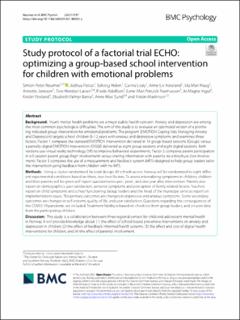| dc.description.abstract | Background
Youth mental health problems are a major public health concern. Anxiety and depression are among the most common psychological difficulties. The aim of this study is to evaluate an optimized version of a promising indicated group intervention for emotional problems. The program (EMOTION Coping Kids Managing Anxiety and Depression) targets school children 8–12 years with anxious and depressive symptoms and examines three factors. Factor 1 compares the standard EMOTION intervention delivered in 16 group-based sessions (Group), versus a partially-digital EMOTION intervention (DIGGI) delivered as eight group sessions and eight digital sessions. Both versions use virtual reality technology (VR) to improve behavioral experiments. Factor 2 compares parent participation in a 5-session parent group (high involvement) versus sharing information with parents via a brochure (low involvement). Factor 3 compares the use of a measurement and feedback system (MFS) designed to help group leaders tailor the intervention using feedback from children with no MFS.
Methods
Using a cluster-randomized factorial design, 40 schools across Norway will be randomized to eight different experimental conditions based on three, two-level factors. To assess internalizing symptoms in children, children and their parents will be given self-report questionnaires pre-, post-, and one year after intervention. Parents also report on demographics, user satisfaction, personal symptoms and perception of family related factors. Teachers report on child symptoms and school functioning. Group leaders and the head of the municipal services report on implementation issues. The primary outcomes are changes in depressive and anxious symptoms. Some secondary outcomes are changes in self-esteem, quality of life, and user satisfaction. Questions regarding the consequences of the COVID-19 pandemic are included. Treatment fidelity is based on checklists from group leaders, and on user data from the participating children.
Discussion
This study is a collaboration between three regional centers for child and adolescent mental health in Norway. It will provide knowledge about: (1) the effect of school-based preventive interventions on anxiety and depression in children; (2) the effect of feedback informed health systems, (3) the effect and cost of digital health interventions for children, and (4) the effect of parental involvement. | en_US |

